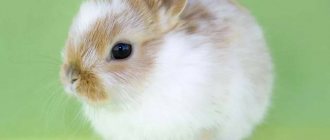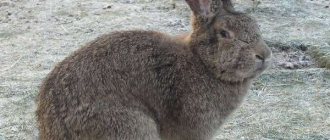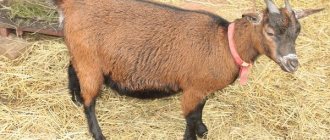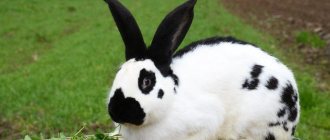Of the more than 90 rabbit breeds - from decorative to large ones - about 15 species are bred in Russia, given the harsh conditions. Rex rabbits stand out among them, although they are rather rare in breeding than vice versa. Expensive dense “plush” skin, high yield of lean and excellent-tasting meat (up to 64%), low feed consumption, relatively low requirements for care and maintenance - this is the value of the breed for farmers. Cleanliness, playful and cheerful character make it possible to breed them at home, so sometimes Rexes replace decorative dogs. A detailed description of rexes, the characteristics of their breeding, maintenance and care is presented below.
The main value of the Rex is their “plush” skin
History of origin
Rex rabbits are a relatively young breed. They were developed in France at the very beginning of the twentieth century. By their type, these animals belong to meat-skin short-haired rabbits. It was for the amazing properties of its fur that the breed got its name - “Rex”, which means “king” in Latin.
For the first time, fluffy “king” rabbits were shown to the general public in Paris, at a rabbit breeding exhibition, in 1924. Their very first appearance created a real sensation because of their amazingly beautiful coat. Immediately after the end of this exhibition, the rexes began their rapid march through the countries of the world: from European countries to the American continent.
Rex rabbits owe their appearance as an independent breed to... an accident! Their ancestors were rabbits of the Belgian giant breed, which, as a result of an accidental intraspecific mutation, produced offspring with short hair. The breeder really liked the unusual rabbits, and he began work to consolidate this quality. It should be said right away that his work was a success.
Rex rabbits appeared on the territory of our country during the Soviet Union. In those years in Germany, it was strictly forbidden to export animals of this species outside the country. However, this did not bother the Soviet rabbit breeder scientist named Serebrovsky at all.
He circumvented this ban in the most elementary way - he crossed the “king” with an ordinary rabbit, and brought the resulting offspring to Russia as ordinary ordinary rabbits. Upon arrival home, these rabbits were crossed with each other, and the offspring obtained as a result of inbreeding again displayed all the characteristics of purebred Rex.
Diseases and their treatment
Rexes are prone to all the typical rabbit diseases. Pododermatitis or corns occur. To avoid this dangerous disease, it is important to properly arrange the floor in the rabbitry and avoid mesh covering.
Animals often suffer from rhinitis of an infectious and cold nature.
To prevent infection, the microclimate in the room should be controlled, vaccinations should be carried out in a timely manner and vitamins should be given to improve health. And if you do not regularly comb the hair, it loses its decorative appearance, and there is a risk of developing alopecia.
As a mandatory vaccination, young animals are vaccinated against myxomatosis, viral hemorrhagic fever and rabies.
External data
Rex rabbits are large in size. Weight from 3.5 to 4.8 kg. The body is compact, rounded. Often the animal's body is wider than its head. Rabbits have a well-developed dewlap.
Comment! A characteristic feature of a Rex rabbit is shortened curled mustaches or their complete absence. The nails should be the same color as the fur on the paws.
There are approximately 20 fur colors. For example, white, blue, lilac, agouti, black, brick and speckled.
Varieties of the Rex breed
Most often, it is customary to divide the varieties of this breed by type of color and other exterior differences such as height, weight, etc.
Rex Marder's fur imitates marten fur
Marder
Rex Marder imitates marten fur and is distinguished by a contrasting combination of brown and white. Currently, there are two varieties of marder: large and dwarf.
And Castor's looks like beaver fur
Castor
The color of the “Castor” coat is similar to the valuable fur of a beaver. It differs from the marder by a less smooth transition; the color on the body is uniformly brown, and on the belly and chest it is white.
The fur of the Chinchilla Rex is gray and soft, like that of its smaller brother.
Rex-Chinchilla
The fur of this variety of rabbits is most similar to that of a chinchilla. Other breeds of rabbits are already significantly different from the expensive fur of a small rodent and do not look as attractive as Rexes.
The weight of dwarf rexes rarely reaches 1.5 kg
Dwarf Rex
They differ from ordinary rexes in their stockier build, smaller body size up to 14-17 cm in length and significantly lower weight from 0.6 to 1.5 kg. At the same time, the variability of colors remains just as rich.
Character
Western owners claim that these animals have high intelligence, thanks to which it is possible to keep several species in one apartment. Rabbits have such a developed maternal instinct that they even accept other people's rabbits.
They are very mobile, similar to dogs or cats. But with large dimensions this is dangerous, since everything in the apartment will be broken. Therefore, it is better to keep dwarf ones at home.
You also need to know that pets should only be handled with clean hands. They cannot tolerate unpleasant odors and can bite. They can be trained without any problems. They can be trained to come on command and stand on their hind legs!
How to choose a good individual
A healthy rabbit has very dense fur, with hairs growing vertically from the roots. The fur on the back should be 14-17 mm long. Her individual hairs are neither wavy nor curly. When stroking the rabbit with your hand against the grain, they should return to their original position. Otherwise, it means that the wool is very thin. There may be curly or wavy hairs on the back of the head and belly. The smoother the wedge on the back of the head, the better the structure of the hairs on the body. A healthy rabbit - with a clean tail, lively eyes, a dry nose, when you take it by the scruff of the neck, it does not hang down, but tenses like a spring. The baby rabbit must have developed bones, it must have a body and head typical for the breed.
Subspecies
The unique skin, due to its qualities, occupies a podium in the production of various products. Using delicate fur, similar to velor, an imitation of the expensive and rare fur of other animals is made.
Rex marder
The highly prized marten fur was imitated by breeding a marder-colored rabbit. There are two varieties: regular and dwarf. The dwarf is popular because of its interesting color, at the same time as the regular one due to its mass.
Dwarf pets weigh from one to one and a half kilograms. They have elongated ears and bodies. Silky and soft fur can have different colors. Most often, dwarf Rexes are kept as pets.
Castor rex
The color of the Castor rex rabbit imitates the valuable skin of a beaver; its name, translated from Latin, means “beaver kings.”
The spine of such individuals has a burgundy-brown tint. The sides of these rabbits are light silver. The quality of the fur is high.
Rex chinchilla
Chinchillas are very rare.
The fur of this breed is best suited for counterfeiting chinchilla skins. The percentage of this color out of the entire livestock is negligible. The skins of such animals look nobler and more elegant.
Productive qualities
The weight of an adult rex can reach 5 kg. Due to the fact that it has light bones, most of the live weight is dietary and very tasty meat. Rex gains weight relatively quickly: 2 – 2.5 kg in 4 months. But other breeds of this type are more often bred for meat.
Find out how to fatten a rabbit for meat in a short time.
Royal rabbits are more prized for their original fur. In addition to high aesthetic qualities, it is very practical. The fur coat is denser than the furs of other breeds and is more wear-resistant. In addition, due to its special texture, the rex skin can be confused with the fur of more valuable fur-bearing animals. Therefore, it is highly valued among fur manufacturers.
Care and maintenance
- Rabbits tolerate frosts well down to – 30 C, but temperatures above + 30 degrees have a bad effect on their health. The ideal temperature for them is from 15 to 25 degrees Celsius;
- Pets can be kept in free enclosures and cages. It is recommended to use hard wood as a material;
- Clean the inside of the cages at least twice a week. You can use regular cat litter boxes as a toilet; the Rex breed is known for its cleanliness and easily gets used to these devices;
- Feeders with food should be firmly fixed to the wall. You can also use cast iron bowls. Animals should not be allowed to spill food and then walk on it. After that, they can pick it up dirty, along with excrement, dust and germs. This can lead to various diseases;
- The drinking bowl must be vacuum: it prevents liquid from spilling throughout the cage;
- It is worth worrying about the animal’s safety: there should be no open wiring or electrical appliances in the house within the animal’s access area.
The use of plastic is prohibited, as the rabbit may begin to chew on the walls of the home.
Possible diseases and prevention
| The most common diseases in Rex rabbits | |||
| Name | Symptoms | Treatment | Prevention |
| Myxomatosis | a) classic type - small gelatinous swelling of the skin; b) nodular type - the presence of tumors on the body. | Ineffective. | Vaccination, quarantine. |
| Hemorrhagic fever | Clinically, the disease is asymptomatic. At first glance, healthy rabbits shudder several times and die. Sometimes they note an increase in temperature to 42C, heavy breathing, runny nose, sneezing, later - diarrhea, loss of appetite, and nosebleeds may occur just before death. | Not provided. | Vaccination, quarantine. |
| Rabies | First, there is a sharp change in periods of apathy and excitement, then there is a lack of coordination, aggressiveness (can sharply bite a person), loss of appetite, water and photophobia, unusual growling, inadequate throwing around the cage, and ultimately the death of the rabbit. | Does not exist. | Vaccination, quarantine. |
| Pododermatitis | The animal moves little, lies for a long time, eats poorly, has bald legs, thinness, calluses, and bleeding on the paws. | Treatment of rabbit paws with hydrogen peroxide or iodine; in case of severe inflammation, antibiotic therapy. | Monitor the condition of the floor in the cage. |
Diet
This breed has an intense metabolism. The animal's diet must include hay and complete pellets. To grind down teeth, you can give branches of deciduous trees.
Stone fruit trees contain a large percentage of hydrocyanic acid, which is necessary for good digestion. Water should always be clean and fresh.
Animals are prohibited from giving:
- Beans;
- Cauliflower;
- A large amount of white cabbage;
- A large number of tomatoes;
- Large amount of salad.
Feeding
The basis of the daily diet is always fresh hay and dry pellets 3 times a day. Aspen or birch bark is excellent for sharpening teeth. As the wood grinds down, it is necessary to change it. Features of the daily menu depend on the time of year:
- In the summer, give your rabbits more fresh grass, fruits and vegetables, and do not forget about fortified feed and the benefits of hay.
- In winter, feed rabbits with compound feed (65% of the daily menu), hay, tree branches, root vegetables, and a mixture of grain crops.
Dill, parsley, cauliflower, carrots and the tops of this root vegetable are especially useful for rabbits. Select vitamin and mineral supplements individually and buy them from veterinary pharmacies.
Breeding
Rabbits purchased and selected for breeding must first undergo quarantine. Even if animals are completely healthy, if their living conditions change abruptly, they can get sick.
It is worth noting that when crossed with individuals of other subspecies, the signs of the Rex breed do not appear in the 1st generation.
These rabbits are bred to obtain beautiful and unusually soft fur, and some enterprising farmers use their accelerated weight gain to obtain tasty and juicy meat.
As a rule, no more than 7 rabbits are born to one female; compared to other breeds, this figure is very low. The survival rate of newborns is also low. If the breeder does not carefully monitor the young animals, you can lose all the babies.
Features of “royal” rabbits
Adult Rex rabbits have an average size and weight of 4-5 kg (females are usually larger than males). The body is oval, up to 54 cm long, the neck is strong, the paws are of medium length. The head is slightly elongated, with a wide forehead. Females have a noticeable massive dewlap. Ears are 11-12 cm long, erect, straight; the upper edge of the ear is rounded. The tail is small, lying close to the back. The eyes and claws are dark brown (except for completely white individuals). The fur on the belly usually repeats the color of the back, but in a lighter version. The whiskers (vibrissae) are short and curved (some animals do not have them at all). This is one of the main breed standards, clearly manifested even in very young rabbits.
Rabbits of this breed group are characterized by small, erect ears and short, curved whiskers.
Fur qualities and popular color options
Rex fur is very different from other breeds in its structure. In this case, the guard hairs are thin and short. They have almost the same length as down ones (no more than 2 cm). All of the animal's hair is erect (each hair grows perpendicular to the surface of the skin). That is why the skin looks as if “trimmed” and is the same over the entire surface of the body. It is very soft, firm and elastic to the touch, reminiscent of plush or velor. The structural features of the skins allow them to be made into imitations of beaver, marten, chinchilla and other types of expensive fur and provide the products with high wear resistance.
Today the most popular Rex cats are the following colors:
- dark brown (“beaver” or castor);
- silver-gray (“chinchilla”);
- tawny ("mustel" or marder);
- blue-black;
- jet black (“black otter”);
- pure white;
- chocolate brown;
- light brown or chestnut (“sable”);
- bright red (“lynx”);
- bluish-gray.
Subspecies with curly hair are divided into the groups Astrex (one of the representatives is in the photo) and Opossum
There are also bicolor varieties, the coats of which have a white background with black, bluish-gray, reddish or brown spots. In addition, during the selection process, rabbits with curly hair began to appear in the offspring of some purebred pairs (the skins are somewhat reminiscent of “crumpled velor” fabric). Today they are divided into the groups Astrex and Opossum, differing in the length of the “curls”.
Breeding
Females can become pregnant from about 5 months of age. Each female rabbit gives birth to 4-5 babies. Despite good maternal care and quite decent milk production, newborn rabbits often die. The fact is that when breeding the breed, numerous closely related crossings were used, which, apparently, did not have the best effect on both the “lighter” constitution of the animals and the survival rate of the offspring.
Females have good maternal instinct and milk production sufficient to feed a small offspring
The young animals, which turn out to be quite strong, grow and gain weight quite slowly: the rabbits reach a weight of 3.5 kg only by 8 months . At this age, those individuals that for some reason are not suitable for growing “for the skin” are usually discarded and slaughtered. This is done because in the next months of life, young animals practically stop growing, and the weight they gain does not compensate for feed costs (that is, fattening the animals “for meat” becomes unprofitable). The timing of slaughtering “skin” specimens usually depends on their age, the season, and even the weather. The owner must time this procedure very carefully in order to obtain the highest quality fur.
All the specific qualities of fur inherent in these rabbits are due to the action of recessive genes. This means that the offspring of mixed pairs (when crossed with other breeds) do not exhibit such characteristics. Therefore, only purebred males and females purchased from reliable nurseries are suitable for breeding “for the skin”.
Purchase
Pets should be purchased when their baby teeth are replaced. You cannot buy babies who are less than 30-40 days old. When purchasing, you need to make sure that the type is original.
To do this, you need to pay attention to parameters that are in no way inherent to this type:
- Body weight less than 3 or more than 5.5 kg;
- Various deviations in the constitution of the body;
- Severe pointedness, excessive thinness or drooping of the ears;
- Clumpy, sparse coat with bald patches;
- Ear length more than 13 cm;
- Hair length more than 24 mm;
- The hair on the ears is poorly developed;
- the presence of a double or triple chin.
Breed standard depending on age
| Age (in months) | Weight |
| 3 | 1 kg 400 gr |
| 4 | 1 kg 900 gr |
| 5 | 2 kg 400 gr |
| 6 | 2 kg 800 gr |
| 7 | 3 kg 300 gr; |
| 8 | 3 kg 500 gr. (but not more than 5 kg) |
Further, body weight gain slows down and on average increases by 200 - 300 grams per month. At eight months of age, the rabbit herd usually thins out: rabbits suitable for further breeding are selected; those that don't fit are slaughtered. It is better to time the selection process in winter, since it is at this time of year that the fur of the animal, which represents the greatest value of the rex, meets all standards and is at the peak of its beauty.
The disadvantages of the breed include:
- body weight is less than three and more than five and a half kilograms;
- thin, pointed, drooping ears/ears longer than 13 cm;
- little ear hair;
- too large double or triple dewlap;
- defects in figure or body composition;
Phlegmaticity and timidity are signs of a sick rabbit
- bad content. To understand this, when selecting a rabbit for breeding, you should pay attention to the hairiness of the paws. The fur there is usually yellowish, but if it is matted or has acquired a dark color, then we can conclude that the rabbit has not been cared for. In addition, some rabbit breeders cull from the herd animals that are too nervous, timid and aggressive;
- presence of signs of infection. The rabbit must be held in your hands: a healthy individual is mobile, with muscle tone and a flexible back, a sick one is phlegmatic, with tousled hair. When selecting, inspect the rabbit’s ears for the presence of parasites, nose, eyes, mouth for the absence of mucous or purulent discharge, evaluate the size of the front teeth (they should not be excessively enlarged, otherwise the rabbit will be uncomfortable eating) and the condition of the hind limbs, which should be large and with thick fur.
Neoplasm in a rabbit's eye
Method number 2: buy a rex from a rabbit farm. First, you can buy a newborn rabbit. In this case, be sure to ask to see both of its parents in a cage (sometimes scam farmers show clients a rabbit in a box, claiming that it is the “father” or “mother”). If the farmer refused to show the premises in which the animals were kept and the parents of the cub, you should refuse the purchase. The fact is that when keeping rabbits, it is necessary to repeat as much as possible the conditions in which they were initially kept. If this is not done, the cubs will die. Therefore, experts advise not to buy animals at poultry markets, where the animal, in addition, can become infected with any disease. On a good rabbit farm with normal prevention, the chances of buying a sick animal are zero.
On a good rabbit farm they will show you the conditions in which the baby rabbit lived and his parents.
Two more factors due to which it is necessary to see the parents are the milk production of the rabbit and the compliance of the animals with the requirements for a rex. Young rabbits for breeding must be selected based on the milk production criterion. If the female invariably brings from five to ten rabbits, feeding them all, and the cubs do not differ from each other in size, therefore, she has enough milk. Milk production is a parameter that is inherited.
If all the rabbits are the same size, then they have had enough mother's milk
Secondly, you can buy an adult for breeding. But there is a certain risk here. Sometimes, after moving, a female rabbit stops reproducing and her litter decreases. An identical situation occurs with mature males, who lose reproduction due to stress after being transported to another place. Therefore, experts still advise purchasing small rexes.
For breeding, it is better to choose baby rabbits rather than adults.
Another tip from rabbit breeders: when a rabbit is purchased from another farm, it needs to be quarantined for three weeks to adapt. The healthiest animals in a new environment can become ill. After isolation, the rabbits are placed with the others, but in an adjacent cage. Before each transplant, the cell is disinfected. The same procedure applies when a pregnant female is about to give birth. Once a week, all care and maintenance items are disinfected - drinking bowls, feeders, etc. When any individual gets sick, the room disinfection procedure is carried out daily.
Video - Buying rabbits for breeding
Video - Examination of the blue-gray rex
Reviews
Angela 07/05/2018 at 16:37
A very cute, funny animal, and it really gets used to new people very quickly. It is unpretentious in nutrition: it eats wheat and special food, and sometimes even dried fruits. He lived with us in a large spacious cage.
Eugene 06.01.2019
Any breed of rabbit needs decent care and attention, otherwise they start to get sick and Rex is no exception. But beginners don’t need to start with the Rex breed; it’s better to practice on ordinary rabbits, and then get this breed with luxurious fur.
Advantages and disadvantages of the breed
Rex rabbits do not leave anyone indifferent; children love them very much. The appearance of the animals is unusual, their character is soft and flexible. The list of advantages of the breed does not end there:
- unpretentiousness in nutrition;
- rapid weight gain;
- delicious dietary meat;
- frost resistance;
- rapid puberty.
Along with the advantages, there are a number of disadvantages of this choice, which are important to know about before purchasing:
- small offspring;
- poor heat tolerance;
- demanding care;
- timidity;
- low stress resistance;
- high mortality rate of young animals due to improper care;
- animals bite when they smell the specific smell of human hands.
How and what to feed
Rex rabbits are unpretentious in food: they eat grain mixtures, vegetables, and alfalfa. Morning and evening are the peak periods of activity, so constant access to food should be ensured. Feeding at least 3-4 times a day. It is necessary to carefully monitor the presence of clean and fresh water in drinking bowls; during cold periods it should be heated.
The diet is based on concentrates and green food; it is important to add minerals and vitamins. From spring to autumn, Rex rabbits eat mainly green food:
- cereals and legumes (clover, alfalfa, corn);
- wild and meadow herbs - nettle, burdock, dandelion, rhubarb;
- kale;
- father-in-law tops, rutabaga, Jerusalem artichoke.
During the cold season (from autumn to early spring), animals require succulent food with additional fertilizers and mineral supplements. Vegetables are not suitable as the main food - they are a supplement, since most are difficult to digest. It is better to choose raw root vegetables:
- carrot;
- zucchini;
- cabbage;
- potato;
- beet;
- pumpkin (boiled or raw).
Roughage should be included in the diet as a source of fiber. Hay should make up a significant portion of the diet. Rough food includes: legumes and cereal grasses (prepared in advance at the time of flowering or before), branches of pine, spruce, juniper, grain.
Concentrated food is considered the most nutritious - a mixture of grains, bran and cake. It has a high content of organic substances, so it provides a lot of energy. For the base, it is better to choose oats (improves the functioning of the digestive system) and corn.
It is important to monitor the quality of the products: remove dirt, rot, moldy and frozen parts. Dangerous products that can harm the health of rabbits:
- tomato tops;
- wild rosemary;
- buttercup, spurge;
- lily of the valley, fern, dope;
- bird cherry, apricot, elderberry;
- beet tops;
- cherry or sweet cherry branches (due to the content of hydrocyanic acid).
How to breed correctly?
The easiest way to increase survival rate is to leave the rabbits to the female
At one time, a female Rex breed can give birth to 5-6 rabbits. No assistance is required during childbirth, unless this is the female’s first litter, then moral and physical support will not hurt, but this can be dealt with without a qualified veterinarian.
Any deviations from care or poor-quality feeding can lead to the death of young animals. The easiest way to increase survival rate is to leave the rabbits to the female. Female Rex have a strong maternal instinct, they even set up a nest before giving birth! Therefore, if you leave newborns to their mother, the chance of survival will increase by 2 times.
Rex rabbits grow quite quickly. At 1 month, young animals weigh up to 650 grams. By the 3rd month the weight reaches 2.1 kg, and by the 4th month – 2.4 kg. They are gradually transferred from milk to food for adults. First, soft hay and softened feed for young animals are given, and only then vegetables, fruits, fresh herbs and other food products can be added. All new products are given little by little, since each individual has its own preferences and body characteristics. If a rabbit has an intolerance to a particular vegetable, it is completely excluded from the diet.
How did the breed appear?
The breed was developed in 1919 in France. From Latin the name "Rex" is translated as "royal"
The variety of rabbits in question was bred in 1919 in France. From Latin the name “Rex” is translated as “royal”. This sonorous name suits the breed very well, which has truly amazing fur. Only 5 years after the breed was developed, it was first presented at an exhibition in Paris and instantly became the favorite of many breeders. After the exhibition, representatives of the species were brought to America, Asia, and spread widely throughout Europe.
Features of fur and products made from it
The quality of a Rex rabbit's fur depends on numerous factors:
- what were the weather conditions in which the rabbit lived;
- breeding region;
- the quality of his feeding;
- correct care;
- the age of its slaughter.
These features will ultimately determine the quality of the fur from which a fur coat or other fur product will be made in the future. The thicker the rabbit's fur was at the time of its slaughter, the warmer the fur coat made from it will be, and the longer it will be worn, maintaining an attractive appearance.
The advantages of products made from Rex rabbit fur are:
- Aesthetic appearance. The fur is soft and delicate. The entire coat is the same length. Outwardly, it seems that it was cut evenly.
- Lightness of the product. A medium-sized rex fur coat weighs approximately 1-1.5 kg. This allows young girls and even teenagers to wear such fur coats.
- Thick pile. A rex fur coat is very warm and perfectly protects from the cold.
- Waterproof. It’s not worth going out in the rain in such a fur coat, and it’s not required. But the snow cannot harm her.
A significant disadvantage of products made from Rex rabbit fur is its low wear resistance. A fur coat wears out quite quickly if worn regularly. However, with proper care of the product it can last up to 15 years.
A special feature of the Rex rabbit's fur is its ability to stretch. Therefore, you should purchase a fur product strictly according to your figure, without the expectation that it will stretch over time.
An interesting feature is that from the wool of a Rex rabbit you can make not only furrier’s products, but also knitted ones.
Over time, any product loses its purity and requires cleaning. Washing is not an acceptable method, so dry cleaning services should be used. It will remove dirt and dust from the fur product. If the damage is not so serious, then individual stains can be removed in the following ways:
- The colorless liquid can be removed by blotting it with a napkin.
- Dirt can be eliminated using starch, which should be mixed with semolina in a 1:2 ratio. The mixture must be rubbed into the stain, then shake it off along with the dirt. Then “comb” the pile with a brush.
- Grease stains can be removed with a solution of half and half vinegar and water.
- If the grease stain is large, it is recommended to use starch mixed with pure gasoline. The resulting pulp should be rubbed into the grease stain. After a few minutes, remove the mixture with a napkin and comb the fur.
Caring for a rabbit fur product involves combing it regularly.











